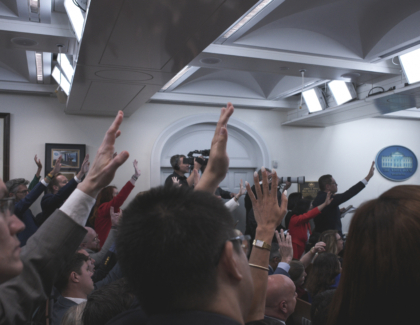Sign up for the daily CJR newsletter.
In late January, after wrapping up his annual State of the State speech, North Dakota governor Doug Burgum (R) headed out to meet the press. Only two reporters awaited him: the North Dakota Monitor’s Amy Dalrymple and Michael Achterling.
“Michael and I were the only ones that were there to ask him questions,” Dalrymple, a veteran reporter previously at the Bismarck Tribune, told CJR. “Because our priority is covering government, we prioritized staying there and asking the governor some questions after his speech.”
The Monitor is one of the latest outlets launched by States Newsroom, a nonprofit operation whose publications on policy and politics have quickly turned it into one of the biggest players in state-level coverage.
States Newsroom now has a full-time presence in all fifty states, after adding outlets in North Dakota and Utah earlier this year and establishing a partnership with Spotlight Delaware, a local nonprofit. The network now has thirty-nine freestanding newsrooms, as well as partnerships with state-focused nonprofit newsrooms in eleven states, including the Texas Tribune, CalMatters, and the Honolulu Civil Beat.
Its expansion is a big part of a growing trend. According to the Pew Research Center, 20 percent of statehouse reporters worked for nonprofits in 2022, up from 6 percent in 2014. By 2022, there were almost as many statehouse reporters working for nonprofit organizations as there were working for local newspapers.
States Newsroom’s team and its partners accounted for a plurality of the 353 reporters tallied in that survey. That number has grown since then: States Newsroom president Chris Fitzsimon told me that the organization now has more than 220 full-time employees, with an annual budget of more than $22 million.
That rapid expansion comes as newspapers and local TV stations are retrenching, laying off reporters and cutting back on state-level coverage as they struggle to survive.
”We’re thrilled that we can fill one of the growing voids in…coverage of state government, which is the level of government that we believe has the most impact on people’s lives,” Fitzsimon said.
The organization has faced criticism in the past from some media watchdogs who accuse it of harboring a left-wing bias because of its donors. That criticism was largely based on its early connection to the Hopewell Fund, a trust funded by left-leaning billionaires that incubated the organization before its launch.
But States Newsroom was spun off to become its own nonprofit in 2019. It doesn’t accept any corporate donations, and publicly shares the sources of all contributions above $1,000. And while many of its larger donors lean left, it’s also received money from center-right groups like the Indiana Chamber of Commerce Foundation, as well as from nonpartisan journalism groups like the National Press Foundation and ProPublica.
While the news coverage strives to be balanced and nonpartisan, the sites’ commentary section leans left. Reporters told me that the mandate from the national office was to find people to contribute progressive-leaning commentary, though they said they were left to define what that meant to them. The only hard-and-fast rule: no commentary from current officeholders or candidates.
Fitzsimon said that the newsrooms’ editorial viewpoint stemmed from his own perspective—and that donors have had no say in shaping the commentary section.
“Like most legacy newspapers, we have an editorial voice and it happens to be center-left, and we have a robust nonpartisan opinion section that includes views of conservatives on a number of local issues,” he said. “Our commentary is pro-democracy, pro-transparency, and clearly labeled as opinion. Like legacy newspapers, our opinion section is completely separate from our news reporting.”
But States Newsroom’s outlets are nothing like the “pink slime” organizations that pass off partisan propaganda as local news.
Many of the journalists running the local newsrooms, which typically employ four to six reporters, had previously been at major state newspapers. The four States Newsroom reporters I spoke to all said they had broad leeway to run their operations as they see fit, with almost no interference from the national operation beyond a broad mandate to cover state politics and policy.
The newsrooms all have full-time reporters covering the state legislature. Some have chosen to have a full-time education reporter, while others have someone focused on agriculture, the state budget, or abortion rights. The Missouri Independent has a reporter focused mostly on cannabis (the state legalized recreational weed last year).
Kathie Obradovich left the Des Moines Register to run the Iowa Capital Dispatch in early 2020 because she wanted to be “part of the solution [to] the deterioration of newspaper journalism.” She’d survived years of rolling layoffs from Gannett, her paper’s parent company, and “never really felt like I knew from day to day whether my job was secure.”
States Newsroom outlets can boast of some major scoops. The Iowa Capital Dispatch was the first to report on a lawsuit alleging that, during the early days of the COVID pandemic, a group of managers at a local Tyson pork-processing plant bet money on how many of their employees would fall ill with the deadly illness, even as they ordered them back to work. The story became international news.
The Missouri Independent, partnering with MuckRock and the Associated Press, published a deeply reported exposé chronicling how federal officials spent decades downplaying the risk of radioactive waste in St. Louis—an investigation based on seventy-five years of government records, many of which had never before been publicly available. Stories like these are often picked up by other publications—which the States Newsroom outlets allow for free, so long as they’re properly credited.
The States Newsroom model is promising, but nonprofit newsrooms aren’t guaranteed success. Chicago Public Media, the parent company of Chicago NPR affiliate WBEZ, was hailed as a light in the darkness when it took over the Chicago Sun-Times two years ago after years of downsizing in both newsrooms. Things are better than they were at both publications, but on Wednesday, Chicago Public Media announced that fourteen of its sixty-two unionized staff would be laid off, citing financial hardships driven by declining fundraising, listenership, and philanthropic support.
Nonprofit journalism isn’t as dependent on generating revenue as traditional businesses, but it still needs to raise enough money to operate—something that depends on persuading donors to stay committed.
The reporters at States Newsroom say they feel less pressure than they did at previous jobs at for-profit publications, where they had to chase clicks and worry about declining revenues.
Jason Hancock, who runs the Missouri Independent, said his new job gives him “more room to breathe” than he had at his previous jobs at the Kansas City Star and St. Louis Post-Dispatch.
“We can kind of step back from that and maybe, hopefully, have a little bit more perspective because we have more resources,” he said. “We’re writing our own future here.”
Other notable stories:
- For Fast Company, Brian Stelter profiled Cesar Conde, the chair of the NBCUniversal News Group, whose leadership has been questioned since his recent hiring and firing of Ronna McDaniel, the former chair of the Republican National Committee, as a paid pundit. Though Conde spoke with Stelter prior to the McDaniel incident playing out, he had previously “hinted at the motivation” for the hire, Stelter writes, describing the news group’s philosophy as wanting “to make sure we have something for everyone.”
- For Esquire, Mark Warren went deep on the story of F.L. “Bubba” Copeland, a pastor and mayor of a small town in Alabama who killed himself last year after 1819 News, a right-wing website, published photos that showed him dressed as a woman and alleged that he had written explicit fiction. “I took to asking the people in Bubba’s life what they might say to the people at 1819 News if they had the chance,” Warren writes. “Several told me that they are required to love them and will be praying for them.”
- Patience Haggin, of the Wall Street Journal, reports that Forbes used an alternative version of its website to run ads that buyers thought they were placing on the site itself—further proof that brands “don’t always get what they pay for” in the digital ad market. The alternative site (which Forbes shut down after the Journal inquired about it) “featured stories from Forbes.com that were stretched into formats that can fit many more ads,” Haggin writes. “One 700-word article was turned into a 34-slide slideshow.”
- Last year, Poland elected a new moderate government that quickly moved to clean house at the country’s state-run broadcaster, which had tilted hard to the right under the previous government. The broadcaster “now airs conventional news bulletins about domestic and international events,” the Financial Times reports—but its ratings have plunged, to the point that an upstart right-wing network, TV Republika, has overtaken it. An anchor on the latter network told the FT that it is explicitly modeled after Fox News.
- And GB News, an upstart right-wing network in the UK, hired Steven Edginton, formerly of the conservative Telegraph, to be its first ever correspondent based in the US—part of a broader plan to expand the network’s reach overseas. (It added an “America” vertical last year.) Geoff Marsh, the chief digital officer at GB News, told Press Gazette that “America has always been our biggest market outside the UK, both with British expatriates but also with Americans who value our British perspective on events there.”
Has America ever needed a media defender more than now? Help us by joining CJR today.







